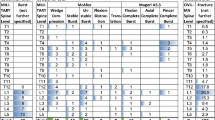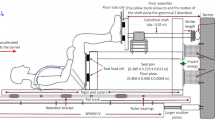Abstract
It is critical to understand the relationship between under-body blast (UBB) loading and occupant response to provide optimal protection to the warfighter from serious injuries, many of which affect the spine. Previous studies have examined component and whole body response to accelerative based UBB loading. While these studies both informed injury prediction efforts and examined the shortcomings of traditional anthropomorphic test devices in the evaluation of human injury, few studies provide response data against which future models could be compared and evaluated. The current study examines four different loading conditions on a seated occupant that demonstrate the effects of changes in the floor, seat, personal protective equipment (PPE), and reclined posture on whole body post-mortem human surrogate (PMHS) spinal response in a sub-injurious loading range. Twelve PMHS were tested across floor velocities and time-to-peak (TTP) that ranged from 4.0 to 8.0 m/s and 2 to 5 ms, respectively. To focus on sub-injurious response, seat velocities were kept at 4.0 m/s and TTP ranged from 5 to 35 ms. Results demonstrated that spine response is sensitive to changes in TTP and the presence of PPE. However, spine response is largely insensitive to changes in floor loading. Data from these experiments have also served to develop response corridors that can be used to assess the performance and predictive capability of new test models used as human surrogates in high-rate vertical loading experiments.















Similar content being viewed by others
References
Alvarez, J. Epidemiology of Blast Injuries in Current Operations: A Survey of Blast Injury across the Full Landscape of Military Science. Halifax: NATO Science and Technology Organization, 2011.
Arepally S., D. Gorsich, K. Hope, S. Gentner and K. Dotleff. Application of mathematical modeling in potentially survivable blast threats in military vehicles. DTIC Document, 2008.
Bailey A. M., J. J. Christopher, K. Henderson, F. Brozoski and R. S. Salzar. Comparison of Hybrid-III and PMHS Response to Simulated Underbody Blast Loading Conditions. In: IRCOBI Conference. Gothenburg, Sweden.
Cormier J. M., S. J. Manoogian, J. Bisplinghoff, C. McNally and S. Duma. The use of acoustic emission in facial fracture detection. Biomedical sciences instrumentation 44: 147–152, 2008.
Draeger, R. H., J. S. Barr, and W. Sager. Blast injury. J. Am. Med. Assoc. 132:762–767, 1946.
Eppinger R. H., J. H. Marcus and R. M. Morgan. Development of dummy and injury index for NHTSA’s thoracic side impact protection research program. SAE Technical Paper, 1984.
Funk J. R., J. R. Crandall, L. J. Tourret, C. B. MacMahon, C. R. Bass, J. T. Patrie, N. Khaewpong and R. H. Eppinger. The axial injury tolerance of the human foot/ankle complex and the effect of Achilles tension. J Biomech Eng 124: 750–757, 2002.
Gayzik F., I. Marcus, K. Danelson, J. Rupp, C. Bass, N. Yoganandan and J. Zhang. A point-wise normalization method for development of biofidelity response corridors. J. Biomech. 48: 4173–4177, 2015.
Gondusky, J. S., MC USN, M. P. Reiter, and MC USNR. Protecting military convoys in Iraq: an examination of battle injuries sustained by a mechanized battalion during operation Iraqi Freedom II. Military Med. 170:546–549, 2005.
Michaelson J., J. Forman, R. Kent and S. Kuppa. Rear seat occupant safety: kinematics and injury of PMHS restrained by a standard 3-point belt in frontal crashes. SAE Technical Paper, 2008.
Ott, K., D. Drewry, III, M. E. Luongo, J. Andrist, R. S. Armiger, J. Titus, and C. Demetropoulos. Comparison of human surrogate responses in underbody blast loading conditions. J. Biomech. Eng. 2020. https://doi.org/10.1115/1.4046638.
Owens, B. D., J. F. Kragh, Jr, J. Macaitis, S. J. Svoboda, and J. C. Wenke. Characterization of extremity wounds in operation Iraqi freedom and operation enduring freedom. J. Orthop. Trauma 21:254–257, 2007.
Paquette S., C. Gordon and B. Bradtmiller. Anthropometric survey (ANSUR) II pilot study: methods and summary statistics. DTIC Document, 2009.
Petitjean A., M. Lebarbe, P. Potier, X. Trosseille and J.-P. Lassau. Laboratory reconstructions of real world frontal crash configurations using the Hybrid III and THOR dummies and PMHS. SAE Technical Paper, 2002.
Pietsch, H. A., K. E. Bosch, D. R. Weyland, E. M. Spratley, K. A. Henderson, R. S. Salzar, T. A. Smith, B. M. Sagara, C. K. Demetropoulos, and C. J. Dooley. Evaluation of WIAMan technology demonstrator biofidelity relative to sub-injurious PMHS response in simulated under-body blast events. Stapp Car Crash J. 60:199–246, 2016.
Pintar F. A., N. Yoganandan, B. D. Stemper, O. Bostrom, S. W. Rouhana, K. H. Digges and B. N. Fildes. Comparison of PMHS, WorldSID, and THOR-NT responses in simulated far side impact. SAE Technical Paper, 2007.
Ragel, B. T., C. D. Allred, S. Brevard, R. T. Davis, and E. H. Frank. Fractures of the thoracolumbar spine sustained by soldiers in vehicles attacked by improvised explosive devices. Spine 34:2400–2405, 2009.
Ramasamy, A., S. E. Harrisson, J. C. Clasper, and M. P. Stewart. Injuries from roadside improvised explosive devices. J. Trauma-Injury Infect. Crit. Care 65:910–914, 2008.
Reed M. P. and S. M. Ebert. The seated soldier study: posture and body shape in vehicle seats. 2013.
Robinson, D. L., K. M. Tse, M. Franklyn, J. Zhang, D. Ackland, and P. V. S. Lee. Cortical and trabecular bone fracture characterisation in the vertebral body using acoustic emission. Ann. Biomed. Eng. 47:2384–2401, 2019.
Salzar, R. S., J. R. Bolton, J. R. Crandall, G. R. Paskoff, and B. S. Shender. Ejection injury to the spine in small aviators: sled tests of manikins vs. post mortem specimens. Aviation Space Environ Med. 80:621–628, 2009.
Slykhouse, L., L. W. Zaseck, C. Miller, J. R. Humm, A. Alai, Y. S. Kang, C. Dooley, D. Sherman, B. Bigler, and C. K. Demetropoulos. Anatomically-based skeletal coordinate systems for use with impact biomechanics data intended for anthropomorphic test device development. J. Biomech. 92:162–168, 2019.
Spink, R. J. A Simple Method for Processing Measurements of Vehicle Response to Underbody Blast During Live Fire Test and Evaluation. Aberdeen Proving Ground: Army Research Lab, 2014.
Spurrier, E., I. Gibb, S. Masouros, and J. Clasper. Identifying spinal injury patterns in underbody blast to develop mechanistic hypotheses. Spine (Phila Pa 1976) 41:E268–E275, 2016.
Stemper, B. D., S. G. Storvik, N. Yoganandan, J. L. Baisden, R. J. Fijalkowski, F. A. Pintar, B. S. Shender, and G. R. Paskoff. A new PMHS model for lumbar spine injuries during vertical acceleration. J. Biomech. Eng. 133:081002, 2011.
Stemper B., J. M. Baisden, N. Yoganandan, D. J. Maiman and F. A. Pintar. Loading rate dependency of thoraco-lumbar spine fracture location: an investigation of trauma in military scenarios. In: Disorders of the Spine and Peripheral Nerves. Orlando, FL, 2012.
Van Toen C., J. Street, T. Oxland and P. Cripton. Acoustic emission signals can discriminate between compressive bone fractures and tensile ligament injuries in the spine during dynamic loading. J. Biomech. 45: 1643–1649, 2012.
Yoganandan, N., M. W. Arun, B. D. Stemper, F. A. Pintar, and D. J. Maiman. Biomechanics of human thoracolumbar spinal column trauma from vertical impact loading. Ann. Adv. Automot. Med. 57:155, 2013.
Yoganandan, N., N. DeVogel, J. Moore, F. Pintar, A. Banerjee, and J. Zhang. Human lumbar spine responses from vertical loading: ranking of forces via Brier score metrics and injury risk curves. Ann. Biomed. Eng. 48:79–91, 2020.
Yoganandan, N., F. A. Pintar, J. R. Humm, D. J. Maiman, L. Voo, and A. Merkle. Cervical spine injuries, mechanisms, stability and AIS scores from vertical loading applied to military environments. Eur. Spine J. 25:2193–2201, 2016.
Zaseck L. W., A. C. Bonifas, C. S. Miller, N. R. Orton, M. P. Reed, C. K. Demetropoulos, K. A. Ott, C. J. Dooley, N. P. Kuo, and L. M. Strohsnitter. Kinematic and biomechanical response of post-mortem human subjects under various pre-impact postures to high-rate vertical loading conditions. SAE Technical Paper, 2020.
Acknowledgments
This effort was funded by Contract #N00024-13-D-6400, U.S. Army Research, Development and Engineering Command (Warrior Injury Assessment Manikin study). The views expressed in this presentation are those of the authors and do not reflect official policy or position of the Department of the Army, Department of Defense or US Government.
Author information
Authors and Affiliations
Corresponding author
Additional information
Associate Editor Stefan M Duma oversaw the review of this article.
Publisher's Note
Springer Nature remains neutral with regard to jurisdictional claims in published maps and institutional affiliations.
Rights and permissions
About this article
Cite this article
Ott, K.A., Demetropoulos, C.K., Luongo, M.E. et al. Evaluation of the Whole Body Spine Response to Sub-Injurious Vertical Loading. Ann Biomed Eng 49, 3099–3117 (2021). https://doi.org/10.1007/s10439-020-02656-0
Received:
Accepted:
Published:
Issue Date:
DOI: https://doi.org/10.1007/s10439-020-02656-0









